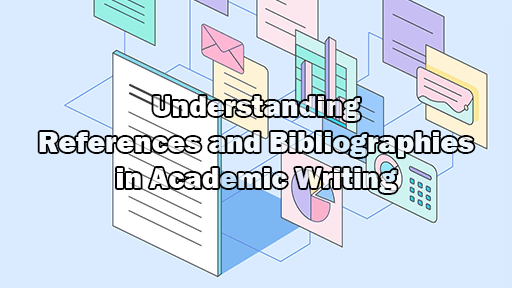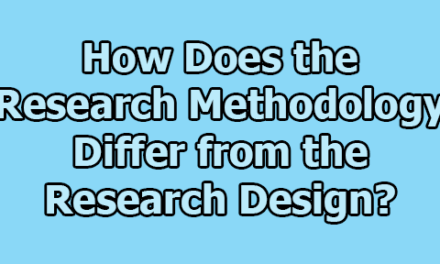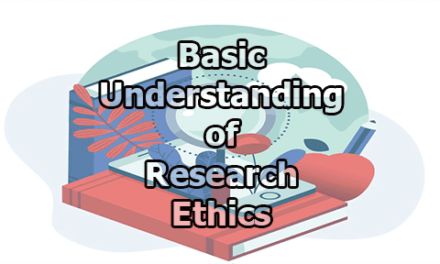Understanding References and Bibliographies in Academic Writing:
It is necessary to cite reliable and appropriate sources of information while conducting research or writing academic papers in order to support your arguments and provide your work trustworthiness. “Bibliography” and “reference” are two terms that are commonly used in this context. In this article, we will explore basic understanding references and bibliographies in academic writing.
What is Reference?
From a scholarly perspective, references are the foundational elements of academic dissertation, serving as indicators that verify and support arguments presented within a text. References, also commonly referred to as citations, are embedded within the body of the document to acknowledge and attribute sources that contribute the claims and assertions made by the author. They typically include essential information such as the author(s) of the source, the publication year, and page number(s) when applicable, offering readers a means to verify and explore the origins of the ideas presented. In essence, references play a pivotal role in maintaining academic integrity, providing evidence to substantiate arguments, and facilitating further engagement with the scholarly community’s body of knowledge.
Types of references:
In academic writing, various types of references are used to cite different sources of information. Here are the most common types of references:
1. Books: References to books include citing single-authored or edited books, textbooks, reference works, and anthologies. They typically include the author(s) or editor(s), publication year, title, edition (if applicable), and publisher.
2. Journal Articles: References to journal articles include citing articles published in academic journals. They typically include the author(s), publication year, article title, journal title, volume and issue numbers, page range, and DOI or URL.
3. Websites and Online Sources: References to websites and online sources include citing web pages, online articles, reports, blogs, and other digital content. They typically include the author(s) or organization, publication or update date, title or description, URL, and access date.
4. Newspaper Articles: References to newspaper articles include citing articles published in newspapers. They typically include the author(s), publication date, article title, newspaper name, section (if applicable), and page number(s).
5. Conference Papers and Proceedings: References to conference papers and proceedings include citing papers presented at conferences or published in conference proceedings. They typically include the author(s), publication year, paper title, conference name, location, and page range.
6. Theses and Dissertations: References to theses and dissertations include citing graduate-level research papers. They typically include the author, publication year, title, institution, and document type (e.g., doctoral dissertation, master’s thesis).
7. Government Documents and Reports: References to government documents and reports include citing reports, white papers, policy documents, and official publications issued by government agencies. They typically include the author(s), publication year, title, issuing agency, report number (if applicable), and URL or DOI.
8. Legal Sources: References to legal sources include citing court cases, statutes, regulations, and legal documents. They typically include the case name, court, decision date, volume and page number(s) for case law, or the title, chapter, section, and publication information for statutes and regulations.
9. Interviews and Personal Communications: References to interviews and personal communications include citing personal interviews, emails, letters, and other forms of direct communication. They typically include the name of the person, the type of communication, and the date.
10. Audiovisual Media: References to audiovisual media include citing films, documentaries, television shows, podcasts, and other multimedia sources. They typically include the creator(s), publication or release year, title, medium (e.g., film, television series), and distributor or platform.
The specific format and details included in each reference may vary depending on the citation style (e.g., APA, MLA, Chicago) and the guidelines provided by the academic institution or publisher.
Benefits of Using Reference:
i. Ensures Academic Integrity: References function as ethical markers, ensuring that due credit is accorded to the original authors whose ideas and findings underpin scholarly discourse. By transparently acknowledging the intellectual contributions of others, references uphold the principles of academic honesty and integrity.
ii. Adds Credibility to Arguments: The inclusion of references imbues scholarly arguments and claims with a layer of credibility and authority. By drawing upon established sources and expert opinions, references lend weight and legitimacy to the assertions made within the text, fostering confidence in the veracity of the author’s arguments.
iii. Enables Verification and Access: References serve as signposts that enable readers to trace the origins of ideas and assertions presented within a text. By providing precise details about the sources consulted, references empower readers to verify the accuracy and reliability of the information presented and facilitate further exploration of the referenced material.
iv. Provides Evidence and Support: References function as conduits for providing empirical evidence and scholarly support for statements and research findings. By citing relevant sources, authors substantiate their arguments with empirical data, theoretical frameworks, and scholarly discourse, bolstering the persuasiveness and validity of their assertions.
v. Helps Avoid Plagiarism: Accurate referencing is instrumental in mitigating the risk of plagiarism by attributing information to its original source. By meticulously citing the works of others, authors uphold academic integrity and demonstrate respect for intellectual property rights, thereby safeguarding against accusations of plagiarism.
vi. Allows for Easy Tracking and Identification: References facilitate the seamless tracking and identification of the sources cited within a document. Through standardized citation formats, such as APA, MLA, or Chicago style, references enable readers to locate and verify the referenced material efficiently, enhancing the transparency and accessibility of the scholarly discourse.
vii. Demonstrates Depth of Research: The inclusion of references serves as a tangible manifestation of the depth and breadth of research conducted on a particular topic. By citing a diverse array of sources, authors demonstrate their engagement with existing scholarship and showcase the extent of their explorations within the field, thereby underscoring the scholarly rigor underpinning their work.
viii. Facilitates Further Exploration: References provide a gateway for interested readers to delve deeper into the cited sources and explore related literature. By furnishing readers with a curated list of references, authors encourage further inquiry and scholarly exploration, fostering intellectual curiosity and enriching the scholarly discourse.
ix. Enhances Overall Quality and Professionalism: The meticulous inclusion of references enhances the overall quality and professionalism of scholarly writing. By adhering to established citation conventions and accurately attributing sources, authors demonstrate a commitment to academic standards of excellence, thereby elevating the stature and credibility of their work within the scholarly community.
x. Enables Contribution to Academic Discourse: References serve as catalysts for scholarly dialogue and intellectual exchange, enabling authors to build upon existing research and contribute novel insights to the academic discourse. By engaging with the ideas and findings of others, authors position their work within the broader scholarly conversation, fostering collaboration and advancing collective knowledge within the field.
Disadvantages of Reference:
- Requires meticulous attention to citation rules and formatting styles.
- Can be time-consuming to locate and cite accurate and relevant sources.
- Difficulties may arise in finding suitable references for specific topics.
- Mistakes in referencing can lead to accusations of plagiarism.
- Some sources may be inaccessible or unavailable for citation.
- Limited availability of certain sources, especially older or rare publications.
- Necessitates staying updated with changes in citation guidelines.
- Overreliance on references may overshadow original thought and analysis.
- Different citation styles may have specific requirements and variations.
- Can be challenging for non-native speakers to understand and apply referencing conventions.
What is Bibliography?
A bibliography is a comprehensive list of all the sources consulted and referred to during the research process. It is typically presented as a separate page or section at the end of a document, providing complete bibliographic information about each source, including author(s), title, publication date, publisher, and more. Bibliographies offer readers an overview of the research conducted on a particular subject and allow for further exploration of the cited sources.
Types of Bibliographies:
In academic writing, various types of bibliographies may be employed depending on the specific requirements of the assignment or publication. Here are some common types of bibliographies:
1. Annotated Bibliography: An annotated bibliography includes a brief summary and evaluation (annotation) of each source cited. It provides additional information about the relevance, quality, and significance of the sources to the topic under consideration.
2. Descriptive Bibliography: A descriptive bibliography provides a detailed description of each source listed, including information about the physical characteristics, publication history, and bibliographic features of the works cited.
3. Analytical Bibliography: An analytical bibliography analyzes the textual or bibliographic features of the sources listed, such as variations in editions, printing history, textual variants, and other scholarly considerations.
4. Selective Bibliography: A selective bibliography includes only a curated selection of sources deemed most relevant or significant to the topic. It focuses on highlighting key works and omitting less pertinent materials.
5. Subject Bibliography: A subject bibliography organizes sources according to specific subject categories or topics. It provides a thematic arrangement of sources to facilitate research and exploration within a particular subject area.
6. Chronological Bibliography: A chronological bibliography arranges sources in chronological order based on their publication or creation dates. It allows readers to trace the development of ideas or historical events over time.
7. Regional or Geographic Bibliography: A regional or geographic bibliography focuses on sources related to a specific geographical region or area of study. It provides resources for researching topics specific to particular locations or regions.
8. Language Bibliography: A language bibliography compiles sources written in a particular language or languages. It may cater to researchers who are interested in studying literature, culture, or other subjects in specific languages.
9. Historical Bibliography: A historical bibliography documents the publication history and evolution of scholarly works on a particular topic over time. It provides insights into the development of scholarship within a specific field or discipline.
10. Specialized Bibliography: A specialized bibliography focuses on sources within a narrow or specialized field of study, such as a particular sub-discipline, methodology, or niche area of research.
Depending on the nature of the research project, the intended audience, and the disciplinary conventions, researchers may choose to use one or more of above types of bibliographies to organize and present their sources effectively.
Benefits of Using Bibliography:
i. Provides a Comprehensive Overview: A bibliography offers a comprehensive snapshot of the research landscape on a given topic, presenting a curated list of sources consulted during the research process. This overview allows readers to grasp the breadth and depth of scholarly inquiry undertaken by the author.
ii. Facilitates Further Exploration: Interested readers can utilize the bibliography to delve deeper into the sources referenced in the document. By providing a curated list of relevant literature, the bibliography serves as a roadmap for readers seeking to explore the topic in greater detail or conduct further study.
iii. Demonstrates Depth and Breadth of Knowledge: A well-constructed bibliography demonstrates the author’s familiarity with a wide array of literature within a specific field or subject area. By encompassing diverse sources, the bibliography showcases the author’s depth of understanding and breadth of knowledge.
iv. Facilitates Verification and Reference: The inclusion of a bibliography enables readers to verify the accuracy and reliability of the information presented in the document. By providing detailed bibliographic information, the bibliography facilitates easy access to the original sources for verification and reference.
v. Enhances Credibility and Reliability: A comprehensive bibliography enhances the credibility and reliability of the research presented in the document. By transparently acknowledging the sources consulted, the author establishes a foundation of trust and integrity with the readership.
vi. Assists in Identifying Related Works: Researchers can use the bibliography as a springboard for identifying related and influential works within the same subject area. By examining the sources referenced in the bibliography, scholars can identify key texts and seminal works that have shaped the discourse in the field.
vii. Encourages Engagement with Existing Literature: The inclusion of a bibliography encourages scholars to acknowledge and engage with existing literature within their field of study. By referencing relevant sources, authors contribute to the ongoing scholarly conversation and enrich the collective body of knowledge.
viii. Enables Readers to Gain a Broader Understanding: Readers can use the bibliography to gain a broader understanding of the topic by exploring a diverse range of perspectives and viewpoints. By consulting the sources referenced in the bibliography, readers can gain insights from different authors and disciplinary approaches.
ix. Serves as a Valuable Resource for Future Researchers: A well-constructed bibliography serves as a valuable resource for future researchers and scholars interested in exploring the same topic. By documenting the sources consulted during the research process, the bibliography provides a foundation for future inquiry and scholarship.
x. Supports Knowledge Sharing and Collaboration: By sharing their bibliography with the academic community, authors contribute to knowledge sharing and collaboration within their field of study. The bibliography serves as a resource that can be utilized by other researchers and scholars, fostering a culture of collaboration and intellectual exchange.
Disadvantages of Bibliography:
- Requires significant time and effort to compile a comprehensive list of sources, adding to the workload of researchers.
- May include sources tangentially related to the research topic, potentially cluttering the bibliography with irrelevant material.
- Difficulties in locating and accessing certain sources, especially older or rare publications, may hinder the completeness of the bibliography.
- Limited availability of older or rare publications can result in gaps in the bibliography, impacting the breadth of coverage.
- Different citation styles with specific requirements and variations can complicate the formatting of the bibliography.
- Mistakes in formatting or inaccuracies in the bibliography can undermine the credibility of the research presented.
- Large bibliographies can overwhelm readers, making it challenging to navigate through the extensive list of sources.
- Some readers may lack access to certain sources cited in the bibliography, limiting their ability to verify and explore the referenced material.
- Understanding and applying bibliographic conventions can be challenging for non-native speakers, potentially leading to errors in citation.
- Adding a bibliography may increase the overall length of the document, potentially affecting readability and conciseness.
Key Differences Between Reference and Bibliography:
Understanding the difference between reference and bibliography is crucial for maintaining academic integrity and producing high-quality scholarly work. Let’s explore the dissimilarities between these two concepts:
| Aspect | Reference | Bibliography |
| Scope | Citations within the text to specific sources. | Comprehensive list of all consulted sources. |
| Placement | Integrated within the text. | Presented separately at the end of the document. |
| Information Provided | Brief details about the source (author(s), year, page number(s)). | Comprehensive bibliographic information (author(s), publication year, page numbers, publisher, edition, DOI, etc.). |
| Purpose | Authenticates claims in the text. | Aids readers in accessing and verifying sources. |
| Length | Limited in number and embedded within the text. | Can be extensive and standalone. |
| Content | Prevents plagiarism and credits original authors. | Demonstrates the breadth of research conducted. |
| Accessibility | Provides immediate acknowledgment. | Aids in locating and exploring sources. |
| Formatting | Follows specific citation styles (e.g., APA, MLA). | Can be formatted diversely. |
| Supporting Arguments | Directly supports arguments and statements. | Provides additional sources for further exploration. |
| Comprehensive Overview | Focuses on specific sources. | Offers a holistic view of research. |
Similarities between Reference and Bibliography:
- Both reference and bibliography provide essential information about the sources utilized in a document, aiding transparency and scholarly accountability.
- They contribute to upholding academic integrity by ensuring proper attribution of ideas and avoiding plagiarism.
- Both reference and bibliography include bibliographic details such as author names, publication dates, and titles, facilitating identification and verification of sources.
- They enable readers to access and verify the cited sources, fostering transparency and trust in scholarly work.
- Both reference and bibliography demonstrate the depth and breadth of research conducted by showcasing the range of consulted sources.
- They play a vital role in acknowledging the contributions of original authors, thereby promoting ethical scholarship.
- Both reference and bibliography can be formatted in various citation styles, accommodating the preferences of different academic disciplines.
- They are indispensable components of scholarly and academic writing, providing the necessary context and support for research findings.
- Both reference and bibliography enhance the overall credibility of written work by substantiating claims and arguments with authoritative sources.
- They facilitate further exploration and study of the cited sources, enriching the scholarly discourse and fostering intellectual inquiry.
In conclusion, understanding the difference between reference and bibliography is vital for conducting thorough research and producing high-quality academic work. While references are specific citations used within the text to support arguments, bibliographies provide a comprehensive list of all sources consulted. References acknowledge and authenticate the sources used, while bibliographies offer readers an opportunity to explore and verify the research conducted. Both reference and bibliography are crucial in maintaining academic integrity, providing evidence, and enhancing the credibility of scholarly work.

Library Lecturer at Nurul Amin Degree College










